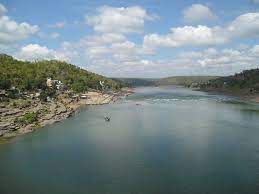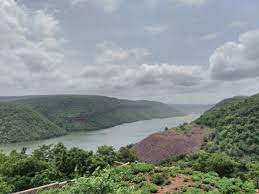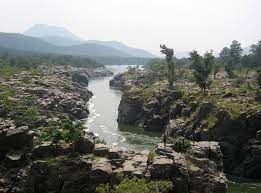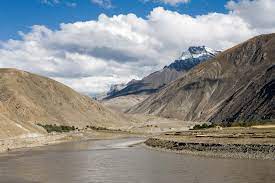12 Holy Rivers in Hinduism

In Hinduism, rivers are often represented as deities. The emergence of human civilization and the early development of culture took place on the banks of the river. In Rigveda, the residence of Aryans has been called the ‘Saptasindhu’ region. In the River Sukta of Rigveda, the description of the rivers flowing in Arya Nivas is found, which are the main ones:- Kumbha (Kabull River), Krugu (Kurram), Gomati, Sindhu,Sutlej, Jhelum, Saraswati, Yamuna and Ganges.
Rivers of Bharatavarsha
A small part of the whole of Jambudvipa was Bharatavarsha and a small part of the whole of Bharatavarsha was Aryavarta. Narmada and Godavari in the middle of India, and Krishna and Kavari in the south. On one side of India, the Indus River and its tributaries flow and on the other side, the Brahmaputra and its tributaries flow. Between the two, the waters of the Ganges lie in the heart of India. This whole area connected with all three and their tributaries was called Bharatavarsha.
Kumbha, Krugu, Gomti, Sindhu, Parushni, Shutudri, Sutlej, Vivasta, Saraswati, Yamuna, Ganga, Narmada, Mahanadi, Brahmaputra, Tapti, Krishna, Godavari, Kaveri, and Brahmaputra are considered as the main rivers of India.

Sindhu River
Sindhu without Hindhu is the same as the body without soul, words without meaning. Before the Ganges, only Sindhu was glorified in Hindu culture. Hindus have a history from Sindhu only.The Indus River has the greatest importance in India and Hindu history. This river, 3,600 kilometers long and several kilometers wide, is mentioned in many places in the Vedas.
Vedic religion and culture originated and expanded on the banks of this river. Sindhu has been given the noun of a great river in Walmiki’s Ramayana. The description of the Sindhu River is found in the Jain text Jambudvi Papragyapati.
Tributaries of Indus
The western side tributaries of Indus – Kubha Suva Stu, Kumu, and Gomati are also mentioned in Rigveda. The tributaries of this river are Vitasta, Chandrabhaga, Iravati, Vipasa, and Shutudri. Shutudri is the largest tributary in it. Asia’s largest Bhagada-Nangal dam is built on the Shutudri river itself. Jhelum, Chinaba, Ravi, Vyas, and Sutlej are the major tributaries of the Sindh River. Besides these, there are other tributaries like Gilgit, Kabul, Swat, Kurram, Tochi, Gomal, Sangar, etc.

Jhelum River
Sri Nagar, the capital of Jammu and Kashmir, is situated on the banks of the Vistasta (Jhelum) River, a tributary of the Indus. The Jhelum River originates from the Sheshna Ga spring in the Himalayas, flows through Kashmir, reaches Pakistan, and joins the Sachchinab near Jhang Maghi or Na Nagar. The flow path of Jhelum which was in ancient China is almost still the same only the course of the course near Chinaba-Jhelum Sangam has changed. This river flows for 2,130 km. This unique Kashmir valley of natural beauty has been formed by the river Jhelum itself.
Swa Yambhuva Manu, the first Manu of the tradition of 14 Manus, and his wife Shatarupa used to reside near the Vitasta river. Manav is believed to have originated near this river. Vitasta is nowadays called the Jhelum river. The battle of Porus and Sikandar took place near this river. This river originates from the middle of the Kashmir valley and divides it into two parts.

Saraswati River
Saraswati also has the same status as the Indus River. It has been described as Annavati and Udakavati in Rigveda. There are many names for the river Saraswati in Mahabharata, Plakshwati river, Vedasmriti, Vedavati, etc. In the Rigveda, the Saraswati river has been described as flowing ‘to the east of the Yamuna’ and ‘to the west of the Sutlej’.
The Saraswati river has been told to dry up in the desert in Tandaya and Jaimi Ni ya Brahmana. In the Mahabharata, there is a description of the Saraswati river disappearing at a place called ‘Vi Na Shan’ in the desert. It was on the banks of this river that there was Brahma Vart, there was Kurukshetra, but today it is burnt there. According to Vedic scriptures, the story of rivers on earth begins with Saraswati. Saraswati, the best among the rivers, first appeared from Brahma Sarovar in Pushkar.
Curse on Saraswati river
Due to the curse of Utathya Muni in the desert, Saraswati disappeared underground and started flowing into the mountains. Saraswati flowing from west to east reached Naimisha Ranya in the far east. Because of reaching Saraswati Kunj with its 7 streams, that area of Naimisha Ranya was called ‘Sapta Sarasvat’. Here Saraswati appeared in the name of Aruna on the call of sages. Aruna descended on earth as the 8th stream of Saraswati. Aruna appeared and joined Kosi river.

River Ganga
In the Vedas and Puranas, the river Ganges has been described as the most sacred among all rivers. In some legends, the goddess Ganga is the daughter of Himavan (an incarnation of the Himalayas) and Mainavati (an Apsara). She is the sister of Goddess Parvati. She is the goddess of chastity and purity, as people believe that bathing in the Ganges washes away sins and helps in attaining salvation. His ride is a creature named Makara.
A legend in the Bhagavata Purana and the Devi Bhagavata Purana describes Ganga as originally one of the three wives of Vishnu, along with Lakshmi and Saraswati. Amid the conversation, Saraswati noticed that Ganga was playfully looking at Lakshmi and Vishnu behind her back. Frustrated, Saraswati unleashes fierce anger against Ganga and accuses her of stealing Vishnu’s love. When Ganga appealed to her husband to help her, he chose to remain neutral and did not want to participate in the feud between his three wives, whom he loved equally.
When Lakshmi tried to appease Saraswati’s anger by reasoning, the jealous goddess became angry with him as well and accused him of being unfaithful to her. He cursed Lakshmi to be born as Tulsi to plant saplings on the earth. Ganga, now enraged that Lakshmi had been cursed because she had protected her, cursed Saraswati that she would descend on earth as a river. Saraswati issued the same curse against the Ganges, telling her that sinners would be cleansed of their sins by her waters.
Legend of Ganga
One of the major legends of Ganga is her descent from Swarga, the heaven of the gods. King Bhagiratha of the Solar dynasty is said to have performed penance to please Ganga and requested her to descend from heaven to earth to free the souls of his ancestors who had perished in Patiala. He informed her that her descent would be so powerful that if she landed directly on his land the earth would be flooded, and so he told her to request Shiva’s help. Bhagiratha performed another penance to please the destroyer god, and Shiva agreed to assist him. When Ganga descended on Earth, Shiva captured her water in his locks and gently released it on Earth. Heeding Bhagiratha’s request, she went down to Patala to ritually purify the souls of her ancestors and then flowed into the ocean.

Yamuna
Yami is the incarnation of the river Yamuna. She is said to be the daughter of the sun god Surya and the cloud goddess Saranyu. She is the goddess of life, and the twin sister of Yama, the god of the underworld. His siblings include Tapati, another river goddess. In later texts, he is known as Kalindi. In the Bhagavata Purana, in a legend related to canal irrigation, the god Balarama once expressed his desire to play with some women in the river Yamuna. When he asked Goddess Yamuna to come near him, she refused to leave his side. So, Balarama used his plow and forcibly dragged the river goddess to the garden where he was standing.

Tapti
Tapti refers to the personification of the Tapti River. Said to be the daughter of Surya and the younger sister of Savitri, she is married in Hindu texts to a king named Samvaran.

Narmada River
Narmada River is also called Rewa River. This river originates from the Amarkantak region of the Maikal hill range of Vindhya Chal of Madhya Pradesh and passes through Sindhusagar (Arabian Gulf) in Gujrat. It fall in Nemavar is situated in the middle of it. Nemavar was called Naimisha Ranya Kshetra in ancient China where sages and sages used to do penance.

Mahanadi
The largest river of Chhattisgarh and Orissa was the origin of Mahanadi Chitro Tapala. Apart from this, it is also known by the names of Maha Nanda and Nilo Tapala. The origin of the Maha River is a mountain named Sihawa, located in the Paddhatari district near Raipur. The flow of this river is from south to north. This river is also called the ‘Ganga of Chhattisgarh’.

Godavari River
Because of the association with Gautama, it was also called Gautami. Godavari is a major river in South India. It originated from Tri Yambak mountain under the mountain range of Western Maghta, which is located in Maharashtra. Here is the Tri Yambakkeshwar Tirth which is in the district of Naik. The longest channel of the river is approximately 900 miles.
Prominent among the tributaries of Godavari are Pranahita, Indra Vati, and Manjra. This river flows through Maharashtra and Andhra Pradesh and joins the Bay of Bengal near the city of Rajahmundry. The main branches of this river are:- Gautami, Vasistha, Kaushiki, Atreyi, Vriddhagautami, Tulya, and Bharadwaji.

Krishna River
Krishna River is an important river of South India, it originates from the mountain Mahabaleshwar (Maharashtra) in the Western Ghats. This river is the second-largest river in India. It is in Maharashtra
After traveling 303 km, 1300 km in Andhra Pradesh, and 480 km in Karnataka, it joins the Bay of Bengal.

Kaveri
The description of Ka Veri, which is called the Ganga of the South, appears again and again in many Puranas. Ka Veri is considered a very holy river. Harangi, Hemvati, Noyil, Amravati, Simsa, Laxmanati Artha, Bhava Ni, and Ka Bini are the main rivers that join the Kaveri River. A detailed description of the kaveri one of this major rivers of the South has been given in the Vishnu Purana.
It originates from the southern end of the Sahyadri Mountains and flows in the south-east direction through Karnataka and Tamil Nadu covering a route of about 800 km to the Bay of Bengal near Veripatnam. There is a dispute between Karnataka and Tamil Nadu over the distribution of its waters.

Brahmaputra
The name of Burma was earlier Brahmavarta because of Brahmaputra. Today it is called Myanmar. Brahmaputra is said to be the son of Brahma (God), that is why he is also called Brahmaputra.
